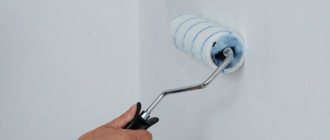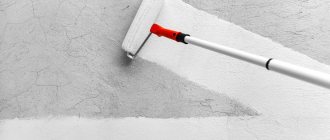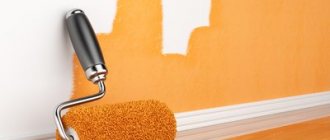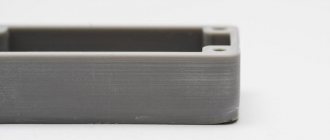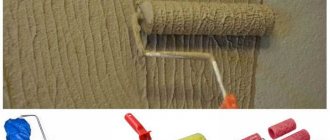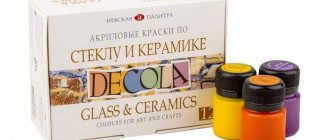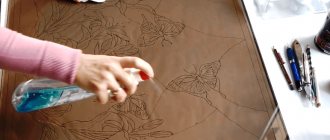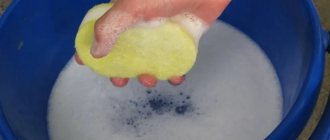Perhaps no repair can be done without painting the surfaces. Processing a large area of walls, floors or ceilings will require a lot of time and effort. To facilitate this complex process, experts recommend choosing the right tools, because it depends on them how quickly you can complete the job and how well the paint will adhere to the surface of the walls.
When choosing between paint brushes and rollers, it is obvious that the latter wins. With such a tool, you can process a larger amount of surface at a time, while the paint layer will be uniform, and the likelihood of streaks and drips is zero. The only difficulty you may have before painting is choosing the right roller. Today, the building materials market can offer a huge range of rollers, each of which is designed for specific types of paint. Below we will discuss this topic in more detail.
Thread roller
A thread or polyamide roller is classified as universal. He received such a high title due to the fact that he copes well with both “light” paints (for example, water-based or dispersion) and “heavy” aggressive compositions (enamels, nitro varnishes and oil paints). The advantages include durability, wear resistance and good absorption and release of paint and varnish compositions.
Pros and cons of working with a roller
Using a roller to paint any walls has many advantages over classic brush painting:
- coverage of a larger area;
- saving time;
- the ability to replace the roller within a minute depending on the work performed;
- working with various types of surfaces;
- a more even result of applying paint without drips or streaks;
- economical paint consumption;
- the ability to work at heights by extending the handle.
However, there are some disadvantages to this tool:
- the cost of a roller is higher compared to a brush;
- difficulty in processing corners, joints and thin elements;
- the need to frequently replace the fur coat.
However, if you take into account all the features of working with the tool, you can save money and paint everything that needs to be painted.
Polyacrylic roller
This type of roller is a budget analogue of a thread roller. Tools made of polyacrylic are less resistant to wear, so it is not recommended to use it for painting rough surfaces. As for the paints for which it is suitable, these are certainly “light” compositions without strong solvents. The polyacrylic roller is ideal for painting surfaces with alkyd, emulsion compositions, and paints based on white spirit.
Types of rollers: which one is better to choose?
The type and quality of the tool used influence the final result no less (and sometimes even more) than the coloring composition itself.
We sweep away the brush right away - it is convenient to paint bevels, wall joints, various recesses and niches, but it is not suitable for painting the ceiling. For this purpose, a roller is used, which provides much greater coverage of the painted surface in one movement. Main types of rollers
In hardware stores you can see many different rollers, which differ in the material used to cover the working surface; in particular, these are:
Rollers coated with natural sheepskin are some of the highest quality. They reduce paint consumption to a minimum and provide an even, uniform coating without lumps. Sheepskin rollers are universal, they are suitable for paints on any base - water-based, acrylic, oil. The only disadvantage of such tools is their price: rollers made of natural material are more expensive than their synthetic counterparts.
Plush and terry rollers are a more budget-friendly option. Their main drawback is their low durability, but they are also inexpensive, so a damaged tool will be easy to replace. The texture of the coating depends on the length of the pile. Rollers with long pile allow you to achieve a smooth, glossy surface, tools with short pile provide a relief texture with microbubbles.
Polyacrylic terry roller
The worst choice for painting ceilings are rollers with a working surface made of foam rubber. They are cheaper than others, but significantly increase paint consumption (it flows off the surface of the roller, staining everything around) and lead to the formation of bubbles on the freshly painted surface, which spoil the texture of the coating.
Rollers with reinforced pile are considered the most durable. Due to the interweaving of synthetic fibers with metal threads, the cover of the working surface is not deformed, maintaining the same length in all areas. Another name for such rollers is “golden thread”. They are even more expensive than sheepskin, but the quality is worth the investment.
There are also special rollers for embossed ceiling finishing. allowing you to leave different patterns on its surface. The working surface of such instruments is made of leather.
Embossed paint rollers
Polyester roller
This type of roller is often chosen because of its low cost. In addition, the polyester tool absorbs paint perfectly, which guarantees uniform application and paint savings. The “coat” of such a roller consists of a polymer fiber that looks like padding polyester or cotton wool, which affects its low wear resistance. Because of this, it is recommended to use a polyester roller exclusively for painting surfaces with emulsion or dispersion paint.
What is a roller
A modern instrument has three main parts: a handle, a fur coat and a core. And the first versions of rollers consisted of a wooden cylinder, a fur coat and a wire axle, which was attached to a wooden handle. In those days, natural fur was used to make fur coats.
And if we talk about modern models, plastic is used to make the core, and a curved metal rod, called a clasp, is attached to it. For fur coats, it is no longer natural fur that is used, but other materials, for example, foam rubber, polyamide or faux fur. The fur coat can also be glued to the core of the instrument or can be secured with plugs. Plastic is usually used to make the handle.
If the coat is glued to the core of the tool, then this option will either be disposable or will last until the coat itself wears out. Therefore, such products are much cheaper than models with removable coats. Due to the fact that the fur coat can be removed and replaced with a new one, you can easily extend the service life of the product.
Types of rollers
These painting devices can be classified according to the material used to make the coat and size. The purpose of the product will depend on these criteria.
So, the first option is a tool with a polyamide coat. Polyamide is an artificial fiber that is highly resistant to wear. It is resistant not only to aggressive components of the dye, but also performs well when working with a rough surface. For this reason, such a tool can be used with nitro paints, enamels and water-based paints. During operation, the fur coat will absorb paint perfectly and transfer it just as well to the surface being treated. You can clean the product after use using a solvent.
The next option is a polyacrylic coat. This material is similar to polyamide, but it is less resistant to aggressive environments. For this reason, it is better not to combine paints with large amounts of solvents with such a fur coat. This product is more suitable for working with water-based compositions or alkyd paints.
A polyester roller can be considered an inexpensive product. Externally, this working part will resemble padding polyester or cotton wool. During operation, the product will absorb the coloring material well and at the same time hold it in itself perfectly, due to this the paint will lie on the surface in an even layer. Since the product is not very wear-resistant, it is better to use it for painting smooth surfaces and use only dispersion or emulsion paints. Coloring compounds with an aggressive environment cannot be used here.
There are also fur coats made of foam rubber. This material also cannot be used with aggressive materials, but it will work great with emulsion paints. Fur coats made of foam rubber are distinguished by their density. The higher the density, the longer the product will last. Such rollers should only be used on a flat surface without roughness.
A tool with a velor coat will become a universal product. It can work with any materials. The solvent is also not harmful to such material, so the tool has a fairly long working life. In this case, the fibers of the product will not leave marks during operation and will not splatter paint. But it is better to work with such a product only on smooth surfaces. It will be difficult to paint rough edges and reliefs with such a roller.
In addition, instruments with a fur coat are produced. Fur can be either natural or artificial. Such products absorb paint well; when applied to the surface, the layers are even and smooth. Natural fur can be used with any dyes and on any surfaces, while artificial fur is suitable for working with water-dispersed materials on smooth surfaces.
Now let's talk about the size of the tool. To treat a hard-to-reach surface, a mini roller is an ideal option. It has a diameter of 15 mm and its length varies from 5 to 24 cm. With its help it is easy to paint corners and small surfaces.
The next option is a universal roller. This instrument is also called a midi roller. This option is in great demand among people doing repairs themselves. With its help you can easily paint walls or ceilings. It has the same length as a mini roller, but its diameter is twice as large.
There is also a front roller. Such products have a length of 15 to 27 cm. During operation, they scroll more slowly than other models, for this reason the paint does not splash during the process and lies in an even layer. The fur coats here usually have a long pile, which allows you to work with any surface.
Terms of use
First you need to prepare the paint composition and clean the surface to be painted.
The paint is poured into a special tray, then the roller is dipped into it. Now you should run the tool along the ribbed part of the bath. This is necessary so that the entire surface evenly absorbs the coloring matter. This procedure should be carried out every time the roller is wetted. Due to this, when working, the paint will lie evenly on the surface, without leaving bald spots.
You should also remember that you need to move the tool smoothly over the surface; sudden movements or jerks will lead to splashes. The pressure should be light, then the strip will be even. You will also probably have to paint the surface in several layers. A new layer is applied only after the previous one has completely dried. In this case, it is necessary to alternate the direction of movement of the tool. Then, as a result, no strokes will be visible and you will get a perfectly painted area.
In addition, do not forget about proper care of the product, so the tool will last longer. After working with emulsion compositions, the fur coat should be washed with ordinary warm water and dried. If enamel was used, then a solvent or acetone will be required to clean the product. But still, after cleaning, such a coat will not show full effectiveness.
Foam roller
Everyone knows what foam rubber is and how well it absorbs water. That is why this type of roller is recommended to be used exclusively for water-based materials. If the paint contains solvents, the foam rubber will begin to deteriorate and the roller will have to be thrown away. By the way, experts recommend using a foam roller when working with varnishes and glue, because it is inexpensive and after completing the repair work, you don’t mind throwing it away.
Which roller is best to paint the ceiling?
Before purchasing a tool for applying paint to the ceiling surface, you should understand that the amount of work can be quite impressive. Many experienced specialists do not recommend giving preference to products of medium or small diameter. In this case, it is best to give preference to large-sized rollers. But you should understand that such products are quite heavy, as a result of which it will be difficult to work with them.
An excellent solution for applying paint would be to choose products whose width does not exceed 30 cm - such rollers are quite easy to work with. To save money, you can pre-purchase replacement elements. This decision is considered reasonable, because the service life of the pen is much longer than the sandpaper included with it. This approach allows significant savings on the metal base.
Which roller is better to paint the ceiling with water-based paint?
In the case when you plan to purchase a roller for water-based paint for the ceiling, you should listen to the opinion of experienced specialists who recommend giving preference to products that have a fairly long pile. This is due to the fact that long-pile rollers absorb paint quite well, making it possible to apply the paint composition as evenly as possible, and the paint will be dense.
It is important to take into account the fact that short pile absorbs a small amount of paint, as a result of which a less dense layer will be applied to the ceiling. That is why the tool will have to be dipped in paint much more often.
However, do not forget that such rollers cannot provide a perfectly smooth surface, which is why this option is best used only for the lower layers. For the final layer, a medium-length nap roller is ideal.
Advice! It is not recommended to purchase foam rubber and velor products.
Which roller is best to paint the ceiling with acrylic paint?
In order to apply acrylic paint compositions to the ceiling surface, it is recommended to use rollers whose coats are made of foam rubber or fur. In this case, the material can be not only natural, but also artificial. When giving preference to a foam coat, you should take into account the fact that during the application process there may be a large amount of splashes, as a result of which everything around will be stained. Such products are not recommended for use by novice painters. An excellent option would be a fur coat with medium-length pile.
Natural fur roller
If you're looking for the perfect roller for working with oil paints and varnishes, this is it. In addition, a tool made from natural fur copes well with water-based and dispersion paints. The “coat” of the roller perfectly absorbs the paint and distributes it evenly over the surface of the walls, floor or ceiling. Such a roller is highly wear-resistant, but on the condition that it will not be used to work with lime paints, since they will destroy the natural material.
How to paint a ceiling using a roller
Painting is carried out in several stages:
- Surface preparation.
After you have removed all the furniture from the room and covered with plastic wrap any that cannot be removed, you can begin preparing the surface for painting.
- First you need to clean it of old whitewash.
- If there are seams on the ceiling, use a spatula to free them from the old putty and carefully seal them with fresh compound.
- Use sandpaper to sand the surface and remove all dust.
After cleaning and treating the seams, a primer mixture is applied
The primer should be applied starting from one of the corners and, moving along the perimeter, proceed to the entire surface of the ceiling, paying special attention to corners and hard-to-reach places. This is done so that the plaster holds tightly and does not crumble. Figure 2
Painting the ceiling with stripes
Figure 2. Painting the ceiling in stripes.
Next, using a special compound and a spatula, you need to plaster the ceiling to obtain a perfectly flat surface. After finishing the putty, you should go over the entire surface with fine sandpaper, destroying all irregularities and defects.
- Coloring.
The choice of paint must be taken very responsibly, because the process and quality of painting, appearance, durability of the finish, as well as the serviceability of the tool will depend on this. If the paint is not thinned enough, the roller will have to work in harsh conditions and will quickly deteriorate. For example, the foam coating begins to delaminate and tear.
Water-based paint is considered the most suitable for painting the ceiling. It ensures the application of an even and uniform layer, dries fairly quickly, is non-toxic, has no unpleasant odor, and is easily washed off from hands and tools.
After all the preparatory work has been completed, you can immediately begin painting the ceiling with a roller.
- Use a brush to paint all corners and other hard-to-reach places.
- Then pour paint into the tray, dip the roller and roll it over the squeezing grid several times.
- After the roller is saturated with paint on all sides, begin painting, rolling it over the surface of the ceiling.
- To ensure that the paint applies correctly and evenly, apply stripes 50 centimeters wide.
- The new strip must overlap the previous one by at least 10 centimeters to avoid any gaps.
- When painting, do not lift the roller from the surface, and as you use up the paint, increase the pressure.
- When the roller runs out of paint, dip it back into the tray.
Figure 3. Painting the ceiling in a perpendicular way.
And so continue until the end of painting.
After you have applied the first layer of paint, you need to wait for it to dry completely, and then apply the second layer in exactly the same way. However, keep in mind that the joints of the first layer should in no case coincide with the joints of the new one.
There are two ways to properly paint the ceiling surface:
- Stripes, from one side to the other and back again. This method allows you to perfectly paint the surface without leaving gaps. Figure 2.
- First, paint the surface horizontally, and apply the second layer vertically. Figure 3.
After finishing the painting work, you need to thoroughly clean the tool and put it in storage.
Otherwise, the tool will become damaged and you will never be able to use it again.
If the work was carried out using water-based paint, it is necessary to wash the tool in water and, in order not to cause its deformation, hang it to dry without squeezing it.
When varnishes or acrylic paints were used to paint the surface, a special composition will be needed. The cleaning procedure must be performed immediately after completion of work.
Velor roller
Rounding out our list is a velor roller. Just like a thread roller, a velor roller is universal and is suitable for finishing surfaces with water-based, acrylic and even oil paints. Velor is not afraid of solvents in paint and varnish products, does not pill, does not cake, and will serve you well. The only caveat is the inability to paint well rough and embossed surfaces.
Now knowing the purpose of each roller, you can easily find the ideal option for yourself and complete your repair quickly and efficiently.
What determines the choice of roller
Which roller is best to paint the ceiling? It's quite simple. The choice of this type of tool directly depends on the quality of the paint and its capabilities. Also, do not discount the quality of the surface itself. So:
- The easiest surface to paint is plasterboard, which can accept any type of paint.
Advice. Before painting drywall, be sure to prime it with a special product.
With plaster the situation is a little more complicated, since after applying paint it is capable of absorbing it and the choice of product must be approached in more detail, as well as the choice of tool.
A separate option for painting: textured rollers
When you want to create an unusual texture on the wall surface, use textured rollers. For the granulating effect, you will need a fur roller and a special textured paint that lies unevenly on the surface. The drawing is applied using a special textured roller - stencil.
Which one is better to choose?
The working tool must be selected in accordance with the expected result. Some types of textured rollers are convenient for creating beautiful patterns, while others are useful for completely painting a wall with a ribbed effect. The aggressiveness of the paint used is also taken into account when choosing a coat of suitable material to match it.
Stencil with a pattern
An interesting option for painting the surface of a room is stencil rollers. Such fur coats are a cylinder on which a pattern protrudes.
Stencil sizes range from small (for painting small areas) to large (they are used to apply a pattern to the entire surface of the wall). The lines connect smoothly, so you can easily paint the entire wall without noticeable joints.
Use does not require skill or much effort. The main thing is to adhere to some rules:
- roll along the wall without pressing too hard, the pace is unhurried;
- New paint is applied when the old one is completely finished.
Wide with pattern
The main advantage of wide stencil rollers is the quick painting of an area. The roller with the stencil is easy to match with the pattern applied earlier, which visually creates the feeling of a complete pattern.
